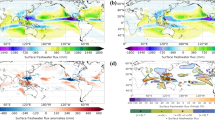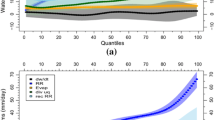Abstract
In this study, three tropical cyclones (TCs) that passed through the Taiwan Strait were analyzed; our results show that precipitation is not directly related to the intensity of TCs. From the perspective of water budget, moisture flux convergence was dominant and contributed ∼70% of the moisture for TC precipitation over the ocean and almost all over the land, especially inside the TC circulation. Their spatial distributions were also similar. Evaporation contributed ∼30% of the moisture for precipitation over the ocean but changed little with the time. Moisture flux convergence can be divided into two parts: wind convergence and moisture advection. Moisture flux convergence was mostly due to wind convergence, which was dominant in the southwestern quadrants of the TCs. Moisture advection was located in the northern area, and becomes relatively important when the TCs approached the land. The moisture flux convergence and its two parts varied during TC movement, with strengthening and contraction of moisture convergence present near landfall. The vertical structure of the three TC cases all indicated that the moisture convergence was mainly confined to the lower atmosphere under 800 hPa and a weak divergence region was present in the middle troposphere around 550 hPa.
Similar content being viewed by others
References
Anthes, R., 1982: Tropical Cyclones: Their Evolution, Structure and Effects. Meteorological Monographs, Vol. 19, No. 1, Amer. Meteor. Soc., 208pp.
Blake, E. S., C. W. Landsea, and E. J. Gibney, 2011: The deadliest, costliest and most intense United States tropical cyclones from 1851 to 2010 (and other frequently requested hurricane facts). NOAA, Technical Memorandum NWS-NHC-6, 49pp.
Charney, J. G., and A. Eliassen, 1964: On the growth of the hurricane depression. J. Atmos. Sci., 21(1), 68–75.
Chen, J., and R. Huang, 2007: The comparison of climatological characteristics among Asian and Australian monsoon subsystems. Part II: Water vapor transport by summer monsoon. Chinese J. Atmos. Sci., 31(5), 766–778. (in Chinese)
Chen, L., X. Xu, Z. Luo, and J. Wang, 2002: Introduction to Tropical Cyclones Dynamics. China Meteorology Press, Beijing, 317pp. (in Chinese)
Chen, L., Y. Li, and Z. Cheng, 2010: An overview of research and forecasting on rainfall associated with landfalling tropical cyclones. Adv. Atmos. Sci., 27, 967–976, oi: 10.1007/s00376-010-8171-y.
Emanuel, K., 1986: An air-sea interaction theory for tropical cyclones. Part I: Steady-state maintenance. J. Atmos. Sci., 43(6), 585–604.
Emanuel, K., 1988: The maximum intensity of hurricanes. J. Atmos. Sci., 45(7), 1143–1155.
Emanuel, K., 2003: Tropical cyclones. Annual Review of Earth and Planetary Sciences, 31, 75–104.
Emanuel, K., C. DesAutels, C. Holloway, and R. Korty, 2004: Environmental control of tropical cyclone intensity. J. Atmos. Sci., 61(7), 843–858.
Gao, S., Z. Meng, F. Zhang, and L. F. Bosart, 2009: Observational analysis of heavy rainfall mechanisms associated with severe tropical storm Bilis (2006) after its landfall. Mon. Wea. Rev., 137(6), 1881–1897.
Ge, X., T. Li, S. Zhang, and M. Peng, 2010: What causes the extremely heavy rainfall in Taiwan during typhoon Morakot (2009)? Atmos. Sci. Lett., 11(1), 46–50.
Hill, K. A., and G. M. Lackmann, 2009: Influence of environmental humidity on tropical cyclone size. Mon. Wea. Rev., 137(10), 3294–3315.
Hong, C.-C., M.-Y. Lee, H.-H. Hsu, and J.-L. Kuo, 2010: Role of submonthly disturbance and 40–50 day ISO on the extreme rainfall event associated with typhoon Morakot (2009) in southern Taiwan. Geophys. Res. Lett., 37(8), L08805, doi: 10.1029/2010GL042761.
Huang, R., and J. Chen, 2010: Characteristics of the summertime water vapor transports over the eastern part of china and those over the western part of china and their difference.Chinese J. Atmos. Sci., 34(6), 1035–1045. (in Chinese)
Huffman, G. J., and Coauthors, 2007: The TRMM multisatellite precipitation analysis (TMPA): Quasiglobal, multiyear, combined-sensor precipitation estimates at fine scales. J. Hydrometeorol., 8(1), 38–55.
Jiang, H., J. B. Halverson, and J. Simpson, 2008a: On the differences in storm rainfall from hurricanes Isidore and Lili. Part I: Satellite observations and rain potential. Wea. Forecasting, 23(1), 29–43, doi: 10.1175/2007WAF2005096.1.
Jiang, H., J. B. Halverson, J. Simpson, and E. J. Zipser, 2008b: On the differences in storm rainfall from hurricanes Isidore and Lili. Part II: Water budget. Wea. Forecasting, 23(1), 44–61.
Kepert, J. D., 2010: Tropical cyclone structure and dynamics. Global Perspectives on the Tropical Cyclones, J. C. Chan and J. D. Kepert, Eds., World Scientific, 3–54.
Kurihara, Y., 1975: Budget analysis of a tropical cyclone simulated in an axisymmetric numerical model. J. Atmos. Sci., 32(1), 25–59.
Knutson, T. R., and Coauthors, 2010: Tropical cyclones and climate change. Nature Geoscience, 3(3), 157–163.
Liang, J., L. Wu, X. Ge, and C.-C. Wu, 2011: Monsoonal influence on typhoon Morakot (2009). Part II: Numerical study. J. Atmos. Sci., 68(10), 2222–2235.
Marks, F. D., 1985: Evolution of the structure of precipitation in hurricane Allen (1980). Mon. Wea. Rev., 113(6), 909–930.
Mrowiec, A. A., S. T. Garner, and O. M. Pauluis, 2011: Axisymmetric hurricane in a dry atmosphere: Theoretical framework and numerical experiments. J. Atmos. Sci., 68(8), 1607–1619.
Ooyama, K., 1969: Numerical simulation of the life cycle of tropical cyclones. J. Atmos. Sci., 26(1), 3–40.
Ooyama, K. V., 1982: Concenptual evolution of the theory and modeling of the tropical cyclone. J. Meteor. Soc. Japan, 60(1), 369–380.
Peixoto, J., and A. Oort, 1992: Physics of Climate. Springer-Verlag, 520pp.
Rotunno, R., and K. Emanuel, 1987: An air-sea interaction theory for tropical cyclones. Part II: Evolutionary study using a nonhydrostatic axisymmetric numerical model. J. Atmos. Sci., 44(3), 542–561.
Saha, S., and Coauthors, 2010: The NCEP climate forecast system reanalysis. Bull. Amer. Meteor. Soc., 91(8), 1015–1057.
Schade, L. R., 2000: Tropical cyclone intensity and sea surface temperature. J. Atmos. Sci., 57(18), 3122–3130.
Smith, R. K., 1997: On the theory of CISK. Quart. J. Roy. Meteor. Soc., 123(538), 407–418.
Trenberth, K., 1991: Climate diagnostics from global analyses-conservation of mass in ECMWF analyses. J. Climate, 4(7), 707–722.
Trenberth, K. E., C. A. Davis, and J. Fasullo, 2007: Water and energy budgets of hurricanes: Case studies of Ivan and Katrina. J. Geophys. Res., 112, D23106, doi: 10.1029/2006JD008303.
Trenberth, K. E., and J. Fasullo, 2007: Water and energy budgets of hurricanes and implications for climate change. J. Geophys. Res., 112, D23107, doi: 10.1029/2006JD008304.
Wang, Y., and J. Xu, 2010: Energy production, frictional dissipation, and maximum intensity of a numerically simulated tropical cyclone. J. Atmos. Sci., 67(1), 97–116.
Wu, L., J. Liang, and C.-C. Wu, 2011: Monsoonal influence on typhoon Morakot (2009). Part I: Observational analysis. J. Atmos. Sci., 68(10), 2208–2221.
Xu, J., and Y. Wang, 2010: Sensitivity of tropical cyclone inner-core size and intensity to the radial distribution of surface entropy flux. J. Atmos. Sci., 67(6), 1831–1852.
Yang, M.-J., S. A. Braun, and D.-S. Chen, 2010: Water budget of typhoon Nari (2001). Mon. Wea. Rev., 139(12), 3809–3828.
Zhang, F., 2011: The future of hurricane prediction. Computing in Science and Engineering, 13(1), 9–12.
Zhang, F., Y. Weng, Y.-H. Kuo, J. S. Whitaker, and B. Xie, 2010: Predicting typhoon Morakot’s catastrophic rainfall with a convection-permitting mesoscale ensemble system. Wea. Forecasting, 25(6), 1816–1825.
Author information
Authors and Affiliations
Corresponding author
Rights and permissions
About this article
Cite this article
Wu, W., Chen, J. & Huang, R. Water budgets of tropical cyclones: Three case studies. Adv. Atmos. Sci. 30, 468–484 (2013). https://doi.org/10.1007/s00376-012-2050-7
Received:
Revised:
Published:
Issue Date:
DOI: https://doi.org/10.1007/s00376-012-2050-7




